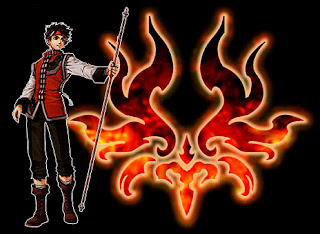A STRONG cough rattled in the foreman’s chest as he sat poring over the floor plans of future buildings. It came in sputters and spurts in the back of his throat. By all rights, Jollum thought, he should be dead and buried.
The Halfling tried to remember how long it had been since contracting the disease that left him this way. Fifteen summers ago, wasn’t it? Maybe seventeen. In fact, it had been twenty years since this affliction left him a wreck of a man with barely a breath in his body. His chest heaved with fear of those days when he almost died. Jollum’s mind began to race with his heart when he thought of what happened soon after that: he met the Benefactor.
The Benefactor helped the pain of his affliction go away when he asked, making him feel alive again. Jollum was so happy, he pledged his life to the Benefactor to do her bidding. She then said the strangest thing in reply: she “knew” that he would. From that moment on, he did whatever the Benefactor asked, never questioning but always wondering and thinking of his actions. One day, Jollum tried to do something he normally did and he received two surprises. When the first surprise made him jump, that was all and nothing else. The following revelation that came to him was the second surprise.
“Mister Jollum!” came the call.
Jollum jumped in his seat and spoke, “Who asks?”
A slender hand pulled aside the tent flap. Familiar gray-green eyes and a curly mop of hair poked in through the opening. “It’s me, Inia. Can I come in?”
Jollum hefted himself up to spread his arms, joints popping and cracking with age as he did. “Yes, my child,” the foreman said as loudly as he could. “Do come in.”
Inia strolled into the tent, past the worn hammock and asked him how he was doing, getting the usual negative prognosis. “You poor man,” she cooed and kissed his forehead. She then said, “I think I may have something that’ll make you feel better.”
“What, child?” Jollum asked.
Inia reached outside of the tent’s flap and pulled in Rashad. The foreman looked him over and said, “So, human, you lookin’ for a job?”
“Yes, sir. I need to make my way.”
“I don’t normally hire humans,” Jollum said, “You’d better have some experience.”
Rashad told him how he built his own home with help and that he helped build some Draconian homes. “Draconian, eh? Good stonework, those Draks have. But that’s sandstone.”
“Stone is stone to me, sir,” Rashad said. If this fool was trying to get a job, Jollum thought, he sure wasn’t doing well. He was about to dismiss the young fool when he noticed Inia giving him the look. He had seen that look before: those big pretty eyes asking for something they couldn’t get. In Inia’s case, she usually got what she wanted from Jollum. He knew that she wanted this young man for something. He decided to play it safe, even when any man worth his salt knows that sandstone is softer than the slate they’ll be using.
“Indeed, lad,” Jollum lied. “Indeed. You’re hired.”
.........................................................................
“Crew! Listen up!”
Over the clatter and clang of metal against stone and the drone of sawing wood, the workers somehow heard. They looked down from their perches and walkways on what would be a new town hall for Karmor’s Bend. The lot of them saw what birds knew by heart: the town streets stretching east and west from the town square, balanced on a southbound street like a pair of scales. The southern street led out to the low hills and ended not too far from the biggest house in town, Blackheart Estates.
Their attention was pulled from “the big house”, as some joked, and down to the three figures standing near the foreman’s tent. There stood the foreman himself, that sweet piece of ass Inia and some guy with her.
“Come on outta there, we’ve got a new guy,” Jollum yelled.
The workers made their way down and walked up to the trio. As Rashad looked at the workers, Jollum explained, “Boss’ daughter brought us more help. This is Rashad, everyone. Introduce yourselves, gents.”
Rashad watched as a burly human with skin darker than his walk up and shake his hand, saying, “M’name’s Wyle, I drive the nails in here.” As Wyle left him, a Halfling walked up and stated, “Name’s Cyan. I dig out here.” The Halfling squeezed Rashad’s hand unnecessarily in the handshake and walked away as another approached. Many of the workers who greeted him were either human or Halfling. Rashad got around to meeting most of them when a large red Enigman made its way through the crowd. Suddenly, a large crab claw jutted from the massive, and the ground shook as the Enigman spoke: “BARCRAB.”
“Wh-wh-well, hey…” Rashad stammered as he shook the Enigman’s pincer.
Jollum interrupted, “Waitaminit…where in the Hells is Orcheon?”
“Boss,” Wyle spoke up, “Orcheon said he’s sick and can’t come today. Something about food poisoning.”
“Great.” Jollum looked at Rashad and asked, “You wanna start today, man?”
“Sure!” Rashad piped up.
“Alright, go over there with Wyle and see what he needs help with.” The foreman turned to the girl. “You going home, Inia?”
“Nope,” the girl replied. “I’m gonna go look for a job. Auntie says I have to learn hard work.”
“Then good luck finding a job, lass,” she heard Jollum say without a hint of irony as she walked off to the stable wall. Making her way through the crowd, she walked up to the wall and pulled down the Moira’s Loom House ad. Looking about with a conspiratorial glance to make sure the black hoods weren’t looking, she grabbed the Egress Bar ad also. Inia then made her way home, leaving a rebellious streak behind her on the way to Blackheart Estates.

























